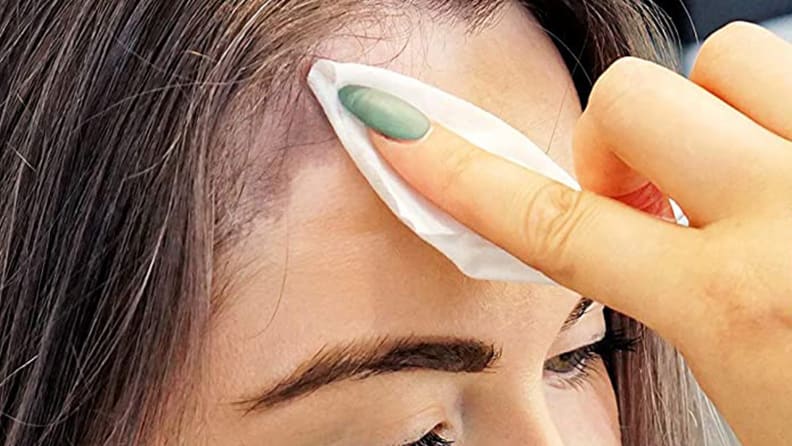Break out these tips next time hair dye stains your skin
Plus some product recommendations from experts
Products are chosen independently by our editors. Purchases made through our links may earn us a commission.
Those of you who color your hair at home know how daunting it can be. It requires quite a few steps, from choosing a color you’ll love, applying the dye as even as possible, and rinsing it out thoroughly—all while trying to maintain clean floors free of dye splotches. But there’s one aspect to at-home hair coloring that has an easy fix: removing hair dye off your skin and scalp (or, really, preventing those stains in the first place). We have answers for why dye stain your scalp, whether it’s actually that harmful for your skin, and how you can prevent and remove it.
Why hair dye stains the skin and scalp
Hair dye stains your skin the same way it colors your hair, according to Dr. Purvisha Patel, board-certified dermatologist and founder of Visha Skincare. “Hair dye is formulated so the pigment molecules are intercalated [sandwiched] either on the hair shaft or inside the hair cuticle to change the hair color,” she says. “Hair is made out of keratin and so are the skin cells, so the pigment can stain both hair and skin.” Also, skin on your scalp and face is more sensitive, so it’s bound to attract dye to a more noticeable degree than anywhere else on your body, says Hairstory colorist Cyd Charisse.
There may even be a downside to having more youthful-looking skin when it comes to dyeing your hair. “I find that the tighter the pores and skin, the more [color] stains,” says Luis Pacheco, celebrity hair colorist and founder of TO112. “I think it's because the color molecules are small before they’re oxidized and expand and fill the hair, or in this case, the skin, so the color gets locked into tighter skin cells and expands, making it more difficult to remove.”
If you’re worried about the effect getting dye on your skin may have, we can put your mind at ease. “All hair coloring that’s formulated for use on the head is safe to come in contact with the scalp,” says Patel.
How to prevent hair dye from getting on the skin
The easiest way to keep dye from staining your skin in the first place is to protect the skin around the area with petroleum jelly, says Patel. Prior to the dye process, apply a layer of an emollient gel, like Vaseline, on the areas of your skin that are most likely to be affected, such as the hairline and skin around the ears. “This creates a barrier and prevents the dye from sticking,” Patel says. Once you’ve finished coloring your hair, remove the dye-infused petroleum jelly with a damp towel.
For the same reason it prevents staining the skin, petroleum jelly may hinder the hair from taking the color, so work slowly to ensure you don’t end up with the formula on your roots while applying it around your hairline.
How to remove hair dye from your skin

Along with at-home remedies, like using a face wash or rubbing alcohol, wipes can help remove hair dye from your skin.
Say your prevention method backfired: Know that your skin is constantly shedding dead skin cells, meaning any errant color should fade in a few days. If you can’t wait the approximate three days Patel estimates it takes for the hair dye to naturally shed off, Charisse says the safest solution is soap and water. “You’ll want to avoid using harsh or abrasive cleansers on your scalp and face to avoid more irritation.” When scrubbing off that excess hair dye, Charisse says to look for a gentle cleanser. One that fills the bill is the Cetaphil Gentle Skin Cleanser that’s fragrance-free and suitable for all skin types.
A cleanser ceases to be gentle if you need to work it into your skin vigorously just to remove the dye. If you find yourself getting to that point, Patel says you can apply rubbing alcohol to a cotton round and dab at the stained area—it'll exfoliate and draw pigment away from the skin cells. Because rubbing alcohol can be extremely drying, be sure to rinse it off with soap and water immediately and follow up with a facial moisturizer, like the Cerave Daily Moisturizing Lotion, which contains hyaluronic acid for hydration and ceramides to protect the skin’s barrier.
If all else fails, there’s one more option: specially designed color-removing wipes. “You can get them in little pre-filled towelettes at any beauty supply,” Pacheco says. “They're formulated to be safe for the skin around the face.” One top-rated option is the package of Framar Kolor Killar Wipes that claims to remove dye using lactic acid (a gentle exfoliant) and dead sea salt while hydrating with aloe vera.
Prices were accurate at the time this article was published but may change over time.


